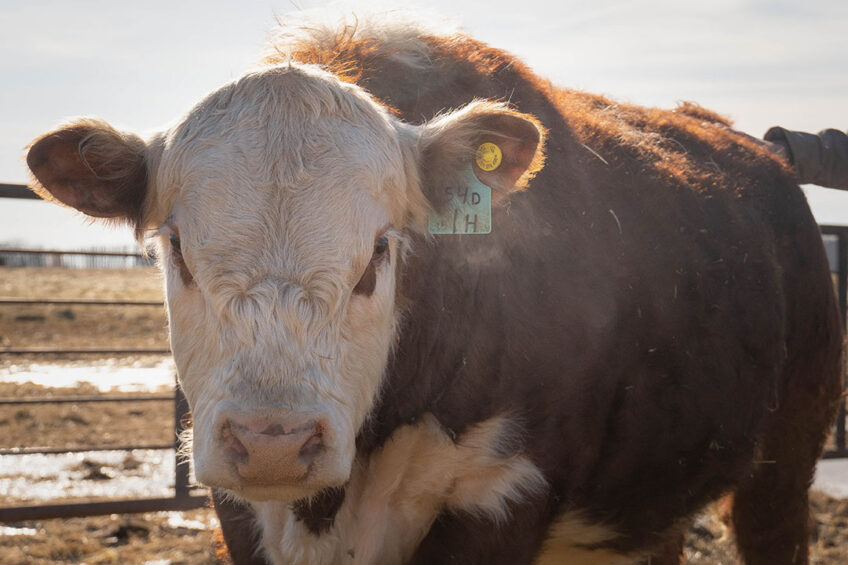Drought in Canadian Prairies urges beef farmers to seek feed alternatives

Drought in parts of the Canadian Prairies during the 2023 growing season slashed feed supplies, prompting beef cattle farmers to seek feed alternatives and even consider reducing their herds.
Canada’s 2 largest beef producing provinces, Alberta and Saskatchewan, representing over 49% and approximately 29% of the national herd, were hardest hit by drought conditions.
Drought took toll on forage
The extreme dryness in turn took a bite out of the hay and forage the sector depends on.
Many parts of Alberta experienced dry conditions and warm temperatures in spring, which accelerated plant maturity, but reduced first cut hay yields. Estimated first cut average dryland yield reached 0.9 tons per acre, 40% below the 10-year average.
Of total dryland hay cut this season, 86% was from the first cut and only 14% from the second, according to the Alberta government’s crop report as of October 3.
Meanwhile, a mere 18% of Alberta’s pastures fell into the good to excellent category, or almost half the 5-year average of 34%. Southern Alberta reported the poorest ratings at 4% good to excellent.
The beef cattle sector is adapting to the situation through alternative feeds. These can include canola by-products like greenfeed, hay, meal, silage and/or straw.
Spring 2023 conditions also drained carryover supplies
“With a cold April and then limited precipitation in May, some cattle producers kept feeding later than usual as pastures were not ready to handle spring grazing at the normal time,” says Alberta government’s livestock market analyst Ann Boyda. “This further depleted some cattle producers’ remaining winter feed supplies and reduced carryover forage supplies.” She says a greater number of cattle and other livestock producers may be looking to secure additional hay from the open market this fall. That is, if they can get it.
Brian Perillat, agribusiness specialist at More Than Just Feed, stresses hay supplies are extremely tight. “It’s been 5, 6 years that we’ve really had no carryover of hay,” he says. “Any available hay is quickly bought up.”
Saskatchewan experienced similar parched growing conditions to Alberta. An October provincial crop report revealed hay and pasture land topsoil moisture was only 19% adequate, while 53% was short and 28% very short. “Some areas of the province were severely affected by drought conditions resulting in low forage yields and poor pasture conditions,” says Saskatchewan government livestock specialist Murray Feist.
While alternative feed options may help reduce feed costs or stretch supplies, farmers are urged to consider the nutritional quality of available feeds.
Robust demand
However, feed demand from livestock producers in Alberta and Saskatchewan remains robust. Boyda says strong consumer demand for beef is driving the market for cattle feed. “Calf and fed cattle prices reached record highs and remain strong even as locally sourced feed grains seem concerning,” she says.
The beef sector is Alberta’s top destination for feed. Based on Animal Nutrition Association of Canada estimates for 2020, the distribution of major livestock species that the feed industry serves in Alberta includes 46.6% beef cattle, 10.6% swine, 10.2% poultry, and 9.3% dairy cattle.
Perillat adds that feed requirements could increase if winter temperatures dip too far. “A big cold snap for 2, 3 weeks, and you burn through a lot of feed,” he says.
Cows will eat more in frigid weather as their metabolic rate rises to increase heat production to help maintain body temperature. Alberta’s agriculture department suggests for every 5°C below -20°C that producers increase the grain they feed their animals by 1 kg (2.2 lbs.).
Producers adapting
The beef cattle sector is adapting to the situation through alternative feeds. These can include canola by-products like greenfeed, hay, meal, silage and/or straw: “Canola by-products can have high crude protein and energy,” says Boyda.
Feed grains currently going to Alberta feedlots are corn, barley, distillers’ dried grains with solubles (DDGS), wheat, and assorted grains such as rye, oats and triticale, she says.
But as feedlots in the Lethbridge area of southern Alberta source corn and barley from farther distances, the feed grain complex becomes vulnerable to logistical issues and rail challenges that tend to occur every year, Boyda warns.
And while alternative feed options may help reduce feed costs or stretch supplies, she urges farmers consider the nutritional quality of available feeds. “For example, straw can be a low-cost alternative feed, however, it requires supplementation with additional energy, protein and minerals to provide adequate nutrition for all classes of cattle,” Boyda says. “Extra protein supplements — grain or peas — will help on that front.” However, these extras and the price to deliver them by truck, will contribute to higher production costs.
Feist reports that Saskatchewan farmers are incorporating cereal greenfeed crops as forage and hay sources for winter feeding. The province’s drought-affected areas are in a forage buying situation, and with harvest completed, feed grains and supplemental pellets are being evaluated for winter ration formulations, he says.
Feed won’t be as short as it was during 2021’s drought
Herd reduction
For many livestock operations, feed represents the highest input cost. Drought only results in higher input costs, and producers in regions where dry conditions were worst may be considering earlier weaning of calves or culling cattle, says Boyda.
Feed costs, dry growing conditions affecting feed and forage supplies, and market returns will affect producers’ decisions on herd size and herd management, adds Feist.
“Some producers have decided to downsize their cattle herds to adjust for lower volumes of local feeds, and to offset/reduce the transport costs for purchased feeds and forages,” he says.
Perillat also anticipates some farmers will be reducing their herd sizes to both capitalise on stronger markets and take some pressure off feed demand. He says that by November, producers should better know their feed resources and manage their herd numbers accordingly.
He points out, however, that feed won’t be as short as it was during 2021’s drought. As well, barley prices are more attractive partly due to US corn imports. Agriculture and Agri-Food Canada expects that feed shortages in Western Canada will lead to a 900,000 tonne increase in total Canadian corn imports to 3 million tons.
Domestic barley buyers also face less export competition thanks to China removing its barley tariffs on Australia. “A combination of more forage out there and barley at $6 a bushel from $8 to $9 previously will make it a little more manageable,” Perillat says. “But some farmers, rather than scramble for feed, will decide to sell some cows.”











